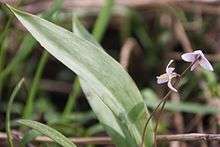Erythronium propullans
Erythronium propullans, the Minnesota dwarf trout lily, Minnesota adder's tongue or Minnesota fawnlily, is a rare plant endemic to the Cannon River and North Fork Zumbro River watersheds in Rice County, Goodhue County and the extreme northern edge of Steele County, Minnesota,[1] in the United States. The plants are believed to be a mutation or sport of the white trout lily (Erythronium albidum) and evolved following the most recent ice age.
| Erythronium propullans | |
|---|---|
 | |
| Scientific classification | |
| Kingdom: | Plantae |
| Clade: | Tracheophytes |
| Clade: | Angiosperms |
| Clade: | Monocots |
| Order: | Liliales |
| Family: | Liliaceae |
| Genus: | Erythronium |
| Species: | E. propullans |
| Binomial name | |
| Erythronium propullans | |
The plants flower in the spring at the same time as Hepaticas, Dutchman's breeches, bloodroot, and other spring wildflowers. Nerstrand-Big Woods State Park, River Bend Nature Center, and several tracts owned by The Nature Conservancy protect portions of its habitat.
Discovery
The lily was first noted by Mary Hodges, a high school science instructor at St. Mary's School (now Shattuck-St. Mary's) in Faribault, Minnesota, and then formally listed as a new species by botanist Asa Gray in 1871.[2]
Reproduction
Research suggests that E. propullans rarely reproduces from seed on its own, but is highly dependent on vegetative reproduction, or limited cross pollination with Erythronium albidum, thus limiting population growth[3] and spread of the species.
Erythronium propullans produces one stolon below the soil surface on the midway point of the stem on blooming plants; that stolon then produces a new bulb. On non-blooming plants, 1 to 3 stolons are produced directly from the bulbs, each ending in a new clone.[4]
Threats
Due to the very limited historical and current distribution of E. propullans, the primary threats include development and flooding along the floodplains and ridges where it currently exists, trampling and recreational use impacts, as well as habitat changes brought on by invasive species such as common buckthorn (Rhamnus cathartica).
References
- Sather, N. (1990). "Minnesota dwarf trout lily: an endangered Minnesota wildflower" (PDF). St. Paul: Minnesota Department of Natural Resources.
- Gray, A. (1871). "A new species of Erythronium". American Naturalist. 5 (5). JSTOR 2447111.
- Banks, Jo Ann (1980). "The Reproductive Biology of Erythronium propullans Gray and Sympatric Populations of E. albidum Nutt. (Liliaceae)". Bulletin of the Torrey Botanical Club. 107 (2): 181–188. doi:10.2307/2484223. JSTOR 2484223.
- Allen, Geraldine A.; Robertson, Kenneth R. (2002). "Erythronium propullans". In Flora of North America Editorial Committee (ed.). Flora of North America North of Mexico (FNA). 26. New York and Oxford. Retrieved 2005-05-10 – via eFloras.org, Missouri Botanical Garden, St. Louis, MO & Harvard University Herbaria, Cambridge, MA.
External links
- Trout Lily Preserve by The Nature Conservancy
- Dwarf Trout Lily by USFWS
- Plant Profile by Center for Plant Conservation
- Spring Wildflowers by River Bend Nature Center
